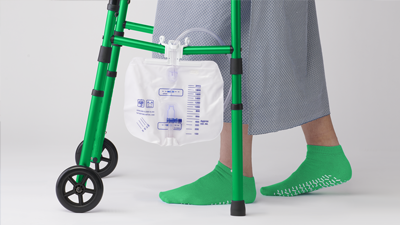5 external catheter myths: How to bust them in your facility
Explore how to prevent CAUTI with appropriate use of today’s products.

Do nurses in your facility automatically insert a Foley catheter when a patient is incontinent? Not so fast. Here’s why:
In the US, up to five million indwelling urinary catheters (IUCs)—or Foleys—are placed annually, with as many as half not being necessary.1 That’s 2.5 million potential catheter-associated urinary tract infections (CAUTIs).
That’s why it’s so important to use Foley alternatives such as external catheters when possible. But clinicians can be resistant to external catheter use due to multiple myths and misconceptions.
Following are five myths about external catheters—and the corresponding realities that will help you gain acceptance of their use:
Myth #1
External catheters aren’t comfortable.
Reality: Modern products are much improved over yesterday’s versions. Condom catheters for males have been around for a while. Older versions may leak, irritate skin and be painful to remove.
Today’s generation of male external catheters are made with gentler materials. For example, a product with a faceplate made of soft hydrocolloid directs urine away from the skin and requires minimal surface coverage for a complete seal. These options provide increased patient comfort and allow more mobility than IUCs.1
External female catheters haven’t been available as long but also have seen improvements. They conform to the perineal area between the labia, against the urethra. The catheter is connected to low continuous suction and includes continuous air flow. These devices allow for ongoing monitoring of continuous output, help in maintaining patient dignity and reportedly improve nurse satisfaction.2
Innovations include a pad and tubing that uses low-pressure suction to pull urine into a canister. The pad is held in place by a soft mesh underwear. These newer devices are designed for a better and more comfortable fit, lower risk of pressure injury and more effective incontinent control.
Myth #2
External catheters aren’t cost-effective.
Reality: While external catheters may seem expensive in the short term, keep in mind that one incidence of CAUTI can cost a hospital from $1,000 to $10,000.3
“A decrease in catheter days is a cost saver for hospitals,” says Jean Ferguson, BSN, CCRN, VA-BC, Medline Manager of Clinical Resources – Acute Care. “They should be using bladder scanners, external catheters and straight catheters—everything across the board—to stay away from catheter days.”
Need proof? In 2019-2020, a hospital used external female catheters for 1,195 patients. Approximately 90% of external female catheter use was to avoid using a Foley catheter. CAUTI rates in bedbound female patients decreased after implementation of the external female catheters. The hospital avoided costs of $13,786 per patient—a total of $16,473,912.4
A decrease in catheter days is a cost saver for hospitals.
Jean Ferguson, BSN, CCRN, VA-BC
Medline Manager of Clinical Resources—Acute Care
Myth #3
External catheters don’t work.
Reality: This assumption is based on episodes of leaking. Again, today’s products function better than older models. And if there’s leakage with a modern device, it probably doesn’t fit right.
“Patients come in different sizes and shapes,” says Ferguson. So you have to make sure that you’re selecting the type and size of external catheter that will fit their needs.”
Your CAUTI team is key to ensuring that the right products are available and accessible. Team members should decide on the types, sizes and quantities to have on hand. Your medical supply partner can help you ensure you have the right products and the right inventory.
Finally, if the device isn’t placed properly, it’s not going to work.
Myth #4
External catheters are difficult to use.
Reality: When staff are provided the right education and training, they can start using the devices and will become more comfortable with each placement. This starts with knowing when alternatives to Foleys can be used. A nurse should assess each patient, following the American Nurses Association evidence-based tool.5
If it’s determined that an external catheter is appropriate, a properly trained nurse, patient care tech or certified nursing assistant can place the device on the patient.
It’s best to include external catheter use in your product bundles, process bundles and protocols. Staff will then know when to use them and for how long. Sometimes these devices can be used after a Foley catheter is removed.
Myth #5
External catheters aren’t hygienic.
Reality: Like a Foley catheter, an external catheter needs the proper care and maintenance to prevent infection.
“A patient with an external catheter still needs perineal care done,” says Ferguson. “And you may need to address existing skin irritation resulting from incontinence.”
You may want to involve a wound, ostomy and continence nurse to help assess existing skin damage or incontinence-associated dermatitis and determine treatment.
You can avoid continued skin irritation by using a protective skin barrier product before applying the external catheter. It’s important to follow manufacturer guidelines and inspect the catheter and skin daily for potential problems.
When possible, engage the patient in decision making and feedback to ensure a comfortable, hygienic experience.
Key takeaway
To prevent healthcare-associated infections such as CAUTI, it’s best to use the least invasive device whenever possible. You’ll want to educate yourself about alternatives and separate myth from reality. When a Foley catheter isn’t necessary for a patient, an external catheter may be the right alternative.
References:
- Institute for Healthcare Improvement. (Updated 2011, December). How-To Guide: Prevent Catheter-Associated Urinary Tract Infections. https://www.alliance4ptsafety.org/IHAMAPS/media/media/HEN/ihihowtoguidepreventcauti.pdf
- Beeson, T., and Davis, C. (March 2018). Urinary Management with an External Female Collection Device. Journal of Wound, Ostomy, and Continence Nursing, 45(2): 187–189. https://www.ncbi.nlm.nih.gov/pmc/articles/PMC5865498/
- ACDIS. (2018, March 1). News: CAUTIs cost anywhere from $1,000 to $10,000 for hospitals. CDI Strategies, 12(9). News: CAUTIs cost anywhere from $1,000 to $10,000 for hospitals | ACDIS
- Tran, C., et al. (2023, January). Addressing CAUTIs with an External Female Catheter. American Journal of Nursing, 123(1), 50-55. Addressing CAUTIs with an External Female Catheter : AJN The American Journal of Nursing (lww.com)
- American Nurses Association. Streamlined Evidence-Based RN Tool: Catheter Associated Urinary Tract Infection (CAUTI) Prevention. Layout 1 (nursingworld.org)





